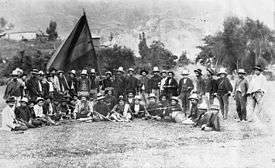Battle of Palonegro
| Battle of Palonegro | |||||||
|---|---|---|---|---|---|---|---|
| Part of Thousand Days War | |||||||
 Conservative soldiers before the battle | |||||||
| |||||||
| Belligerents | |||||||
| Colombian Liberal Party |
| ||||||
| Commanders and leaders | |||||||
| Gabriel Vargas Santos | Próspero Pinzón Romero | ||||||
| Strength | |||||||
| 8,000 | 15,000 | ||||||
| Casualties and losses | |||||||
| 1.500 | 1.000 | ||||||
The Battle of Palonegro started on May 11 and ended on May 26, 1900, in the early days of the Thousand Days War, the commanding general of the Liberal armies, Gabriel Vargas Santos, ordered his troops to retire to Palonegro. Few could have imagined the effect it would have on Colombian history. After the battle, the war took a 180-degree-turn, and became one of the most brutal conflicts in early 20th century South America.
Prelude
After the victory of Peralonso (December 15, 1899), the Liberals could have finished the war, completing the Conservative defeat by marching unopposed on the capital. General Vargas Santos, commander of a Liberal army, believed it was dishonorable to attack the dispersed government army, and ordered that his troops move to Cúcuta, many kilometers from the site of the battle.
When finally in February, fighting off mosquitoes and fever, the General decided to begin small skirmishes, a new Conservative army, fresh and well supplied, under the command of the general Próspero Pinzón, had cut off all routes of escape.
In the darkness
On May 11, 1900, the Liberal advance arrived at the outposts in the Canta mountains, in between Bucaramanga and Lebrija, and there began the most prolonged battle of the war. Fifteen days of combat on a front of 26 kilometers of trenches occurred in the rustic topography of the hills of Palonegro. There, the victory swung with every meter lost or gained, and where machetes and yataganes created a slaughter between both sides.
The burning sun overhead, the suffocating heat, the lack of equipment, the deficiency of efficient "ambulances" and the canteens full of a mixture of brandy with powder all combined with the brutality of a combat where the cutting weapon amputated members and cleaved flesh, condemning its victims to a slow death between the ditches. Long before the end of the battle, the stench of the dead, who shared the trenches with the living, poisoned the air of the region, and darkened the sky with carrion birds, many became anchored to earth because the weight of their banquets was greater than the force of their wings.
After the battle, the doctors who took care of the wounded and buried the dead told chilling stories of the brutal viciousness of the battle. Dead fathers lying next to their deceased adolescent sons, inhabitants of the region looting the corpses of the dead, thousands of corpses covered with flies that laid eggs and ate to multiply their species. They told of women gathering, like in a puzzle, the pieces of their relatives to bury them complete, or those who tried to imagine, between the bodies disfigured by the swelling, some characteristic that identified them with their loved ones.
Many sources put the dead at 2,500(1,500 Liberals and 1,000 Conservatives). This is the result of the battle that reached its end on May 26 when the Liberals began to abandon their positions in order to retreat.
Aftermath
Of all the routes of escape, general Vargas Santos opted for the least expected: the jungle of Teorama. There the Liberals left the fury and the fever that it had when it defeated the Conservative army at the battle of Peralonso.
That day, May 26, 1900, the situation deteriorated even further. The future of the war had been written, the defeat of the Liberals was only a matter of time. It began a devastating war that only existed to prolong the confrontation and to look for the conditions for an honorable peace, that became less and less feasible because the Liberal armies were forces in permanent defeat.
References
External links
- (Spanish) http://www.presidencia.gov.co (Page contains information on number of participants in battle)
- (Spanish) http://www.colombialink.com (LA BATALLA DE PALONEGRO)